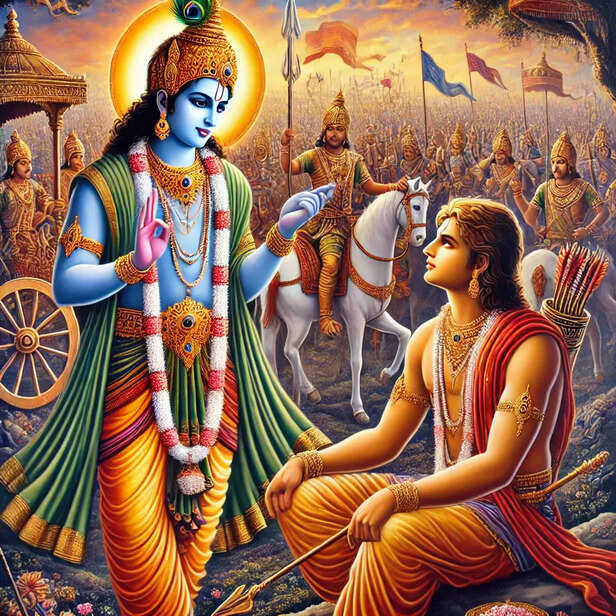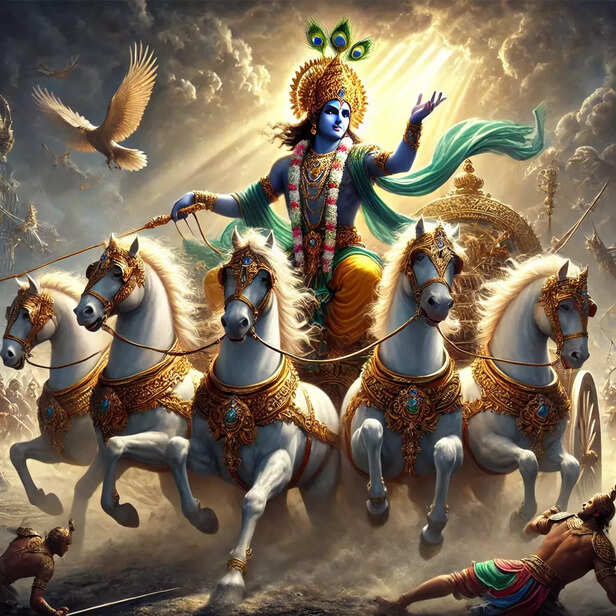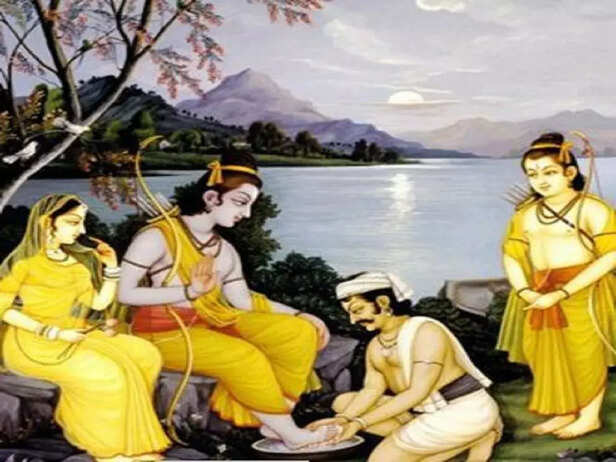Dharma or Karma: What Truly Defines Your Path?
Nidhi | Jan 17, 2025, 02:01 IST
( Image credit : Timeslife )
Dharma and karma are two foundational principles of life explored in the Bhagavad Gita. While dharma refers to righteous duty, karma emphasizes selfless action without attachment to results. Through the timeless wisdom of the Gita and examples from the Ramayana and Mahabharata, this article delves into their harmony, showcasing how dharma guides moral choices while karma brings them to life. The piece offers practical insights on balancing these concepts to lead a purposeful and fulfilling existence.
In the intricate tapestry of life, two threads intertwine to guide our journey—dharma (righteous duty) and karma (action). Both concepts, deeply embedded in the teachings of the Bhagavad Gita, form the foundation of a meaningful existence. Yet, they often present a dilemma: should one prioritize adherence to duties, even at personal cost, or focus on selfless action without attachment to results? By exploring the timeless wisdom of the Gita and drawing parallels from epics like the Ramayana and Mahabharata, we can uncover the profound relationship between dharma and karma and the path they illuminate.

The concept of dharma extends beyond mere rules. It is the moral order of the universe, the principle that upholds harmony in life. Dharma varies according to one’s role in society, circumstances, and stage of life. It is the foundation of integrity and responsibility.
Krishna emphasizes the importance of following one’s own dharma, even if it seems fraught with challenges:
"श्रेयान् स्वधर्मो विगुणः परधर्मात् स्वनुष्ठितात्।
स्वधर्मे निधनं श्रेयः परधर्मो भयावहः।।"
(“It is better to fail in one’s own duty than to succeed in the duty of another. Following another’s path brings fear and insecurity.”)
— Bhagavad Gita, 3.35
In this shloka, Krishna highlights that each individual is born with a specific purpose and responsibilities. To stray from one’s dharma, no matter how appealing, is to invite chaos.
The Ramayana’s Lesson on Dharma
Lord Rama exemplifies the essence of dharma. As a son, he chose to uphold his father’s promise by accepting 14 years of exile. This decision, while painful, preserved the moral fabric of his family and kingdom. Rama’s adherence to dharma, even at personal cost, teaches us that righteousness often demands sacrifice, yet it is the foundation of societal harmony.

Karma is action in all its forms—physical, mental, and spiritual. It is not merely about deeds but the intention behind them. The Bhagavad Gita introduces the concept of Nishkama Karma, or selfless action performed without attachment to results, as the key to liberation.
Krishna explains the essence of karma with clarity:
"कर्मण्येवाधिकारस्ते मा फलेषु कदाचन।
मा कर्मफलहेतुर्भूर्मा ते संगोऽस्त्वकर्मणि।।"
(“You have the right to perform your duties, but never to the fruits of your actions. Let not the results of action be your motive, nor let your attachment be to inaction.”)
— Bhagavad Gita, 2.47
This shloka teaches us to focus on the process rather than the outcome. By detaching from the desire for results, we can act with clarity and purpose, free from fear or expectation.
The Mahabharata’s Insight on Karma
On the battlefield of Kurukshetra, Arjuna is paralyzed by doubt, torn between his duty as a warrior and his love for his family. Krishna urges him to rise above his emotions and fulfill his warrior’s dharma through selfless action:
"तस्मात् असक्तः सततं कार्यं कर्म समाचर।
असक्तो ह्याचरन् कर्म परमाप्नोति पूरुषः।।"
(“Therefore, without attachment, always perform your duty efficiently, for by doing so, one attains the Supreme.”)
— Bhagavad Gita, 3.19
Krishna’s words remind us that karma rooted in dharma is the ultimate expression of a purposeful life.
 At first glance, dharma and karma may appear to conflict—dharma emphasizes adherence to moral principles, while karma focuses on action. However, the Bhagavad Gita reveals that they are deeply intertwined. Dharma provides the ethical foundation, while karma brings those principles to life.
At first glance, dharma and karma may appear to conflict—dharma emphasizes adherence to moral principles, while karma focuses on action. However, the Bhagavad Gita reveals that they are deeply intertwined. Dharma provides the ethical foundation, while karma brings those principles to life.
"धर्म एव हतो हन्ति धर्मो रक्षति रक्षितः।
तस्माद्धर्मो न हन्तव्यः मानो धर्मो हतोऽवधीत्।।"
(“Dharma, when destroyed, destroys; dharma, when protected, protects. Therefore, dharma must never be abandoned, lest it abandon you.”)
— Manusmriti, 8.15
This verse illustrates that dharma safeguards the integrity of our actions. Without dharma, karma loses its purpose and direction. Conversely, without karma, dharma remains unfulfilled.


The teachings of the Gita are not confined to ancient texts; they hold profound relevance in today’s world:
The Bhagavad Gita does not ask us to choose between dharma and karma. Instead, it shows us how to harmonize these principles to lead a life of purpose, integrity, and fulfillment. Dharma is the moral compass, while karma is the action that brings its principles to life.
Krishna’s words resonate across time:
"युक्तः कर्मफलं त्यक्त्वा शान्तिमाप्नोति नैष्ठिकीम्।
अयुक्तः कामकारेण फले सक्तो निबध्यते।।"
(“The one who performs actions while renouncing attachment to results attains peace. The one driven by desire, attached to outcomes, is bound in chains.”)
— Bhagavad Gita, 5.12
As we navigate life’s complexities, the Gita reminds us to live with righteousness, act with purpose, and rise above attachment. By balancing dharma and karma, we not only honor our own existence but contribute to the harmony of the universe.
Let dharma guide you. Let karma drive you. Together, they will lead you to liberation.
Understanding Dharma: The Righteous Duty

Krishna in Mahabharat
( Image credit : Timeslife )
The concept of dharma extends beyond mere rules. It is the moral order of the universe, the principle that upholds harmony in life. Dharma varies according to one’s role in society, circumstances, and stage of life. It is the foundation of integrity and responsibility.
Krishna emphasizes the importance of following one’s own dharma, even if it seems fraught with challenges:
"श्रेयान् स्वधर्मो विगुणः परधर्मात् स्वनुष्ठितात्।
स्वधर्मे निधनं श्रेयः परधर्मो भयावहः।।"
(“It is better to fail in one’s own duty than to succeed in the duty of another. Following another’s path brings fear and insecurity.”)
— Bhagavad Gita, 3.35
In this shloka, Krishna highlights that each individual is born with a specific purpose and responsibilities. To stray from one’s dharma, no matter how appealing, is to invite chaos.
The Ramayana’s Lesson on Dharma
Lord Rama exemplifies the essence of dharma. As a son, he chose to uphold his father’s promise by accepting 14 years of exile. This decision, while painful, preserved the moral fabric of his family and kingdom. Rama’s adherence to dharma, even at personal cost, teaches us that righteousness often demands sacrifice, yet it is the foundation of societal harmony.
Understanding Karma: The Power of Selfless Action

Lord Krishna
( Image credit : Timeslife )
Karma is action in all its forms—physical, mental, and spiritual. It is not merely about deeds but the intention behind them. The Bhagavad Gita introduces the concept of Nishkama Karma, or selfless action performed without attachment to results, as the key to liberation.
Krishna explains the essence of karma with clarity:
"कर्मण्येवाधिकारस्ते मा फलेषु कदाचन।
मा कर्मफलहेतुर्भूर्मा ते संगोऽस्त्वकर्मणि।।"
(“You have the right to perform your duties, but never to the fruits of your actions. Let not the results of action be your motive, nor let your attachment be to inaction.”)
— Bhagavad Gita, 2.47
This shloka teaches us to focus on the process rather than the outcome. By detaching from the desire for results, we can act with clarity and purpose, free from fear or expectation.
The Mahabharata’s Insight on Karma
On the battlefield of Kurukshetra, Arjuna is paralyzed by doubt, torn between his duty as a warrior and his love for his family. Krishna urges him to rise above his emotions and fulfill his warrior’s dharma through selfless action:
"तस्मात् असक्तः सततं कार्यं कर्म समाचर।
असक्तो ह्याचरन् कर्म परमाप्नोति पूरुषः।।"
(“Therefore, without attachment, always perform your duty efficiently, for by doing so, one attains the Supreme.”)
— Bhagavad Gita, 3.19
Krishna’s words remind us that karma rooted in dharma is the ultimate expression of a purposeful life.
Dharma vs. Karma: Complementary Forces

Meera Bhakti
( Image credit : Timeslife )
"धर्म एव हतो हन्ति धर्मो रक्षति रक्षितः।
तस्माद्धर्मो न हन्तव्यः मानो धर्मो हतोऽवधीत्।।"
(“Dharma, when destroyed, destroys; dharma, when protected, protects. Therefore, dharma must never be abandoned, lest it abandon you.”)
— Manusmriti, 8.15
This verse illustrates that dharma safeguards the integrity of our actions. Without dharma, karma loses its purpose and direction. Conversely, without karma, dharma remains unfulfilled.
Examples from the Epics: A Unified Vision
- Rama: The Upholder of DharmaRama’s life was a continuous journey of adhering to dharma. Whether it was respecting his father’s promise, waging war against Ravana to rescue Sita, or ruling Ayodhya as a just king, Rama’s actions were always rooted in righteousness. His story teaches us that dharma is the guiding light in times of uncertainty.
- Krishna: The Embodiment of KarmaKrishna’s life is a celebration of dynamic action. From his role in the Mahabharata war to his counsel to Arjuna, Krishna demonstrated how karma, guided by dharma, leads to liberation. His message was simple: act with purpose, but without attachment to results.

Krishna Teachings
( Image credit : Timeslife )
Practical Lessons for Modern Life

Ramayana
( Image credit : Timeslife )
The teachings of the Gita are not confined to ancient texts; they hold profound relevance in today’s world:
- Identify Your DharmaReflect on your role and responsibilities in life. Are you a parent, a student, a professional, or a seeker? Let dharma guide your actions, ensuring they align with your moral compass.
- Perform Selfless KarmaApproach your duties with sincerity and dedication, but without being consumed by the desire for rewards. This detachment brings peace and fulfillment.
- Align Dharma and KarmaBalance your responsibilities (dharma) with purposeful action (karma). Let one guide the other, ensuring harmony in both thought and deed.
- Focus on the Greater GoodWhen faced with dilemmas, consider the broader impact of your choices. Krishna advises acting for the welfare of all, transcending personal gains.
The Eternal Wisdom of the Gita
Krishna’s words resonate across time:
"युक्तः कर्मफलं त्यक्त्वा शान्तिमाप्नोति नैष्ठिकीम्।
अयुक्तः कामकारेण फले सक्तो निबध्यते।।"
(“The one who performs actions while renouncing attachment to results attains peace. The one driven by desire, attached to outcomes, is bound in chains.”)
— Bhagavad Gita, 5.12
As we navigate life’s complexities, the Gita reminds us to live with righteousness, act with purpose, and rise above attachment. By balancing dharma and karma, we not only honor our own existence but contribute to the harmony of the universe.
Let dharma guide you. Let karma drive you. Together, they will lead you to liberation.
